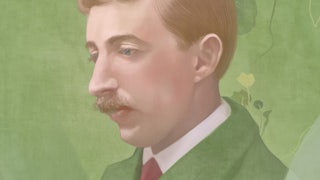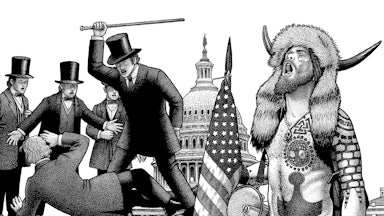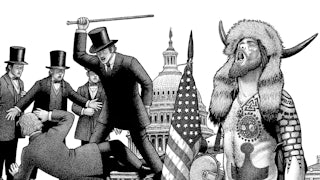I can’t pinpoint exactly when I began to see fatphobia everywhere in American fiction. It did not come all at once, but little by little. I saw it when I was in graduate school and a man turned in a story where a boy looks at a fat girl and thinks not all humans are made in God’s image. I saw it at a bookstore where the bookseller recommended me a novel about a fat man whose life consists only of sad drudgery until an “inciting” incident. Huh, I thought, to the feeling rising inside of me. That’s my life they’re talking about. My image.
I am a novelist and a fat person, and the feeling came again this past March when I saw several writer acquaintances sharing a list The Atlantic put together of 136 works that define the Great American Novel. But while the list highlighted characters of diverse races, ethnic backgrounds, gender identities, and sexualities, those with disabilities were virtually absent. And by my count just one of the selected novels was substantively about a fat person. In the introduction, the list’s authors characterized their mission as selecting works that “accomplished ‘the task of painting the American soul.’” But what about the American body?
More than half of Americans are fat. 2017–2018 data from the National Health and Nutrition Examination Survey indicates that 73.6 percent of Americans are medically classified as “obese” or “overweight.” And yet, I see a notable lack of fiction about fat people’s lives and bodies. Though The New York Times chooses between 40 to 50 fiction titles per year for inclusion in its “100 Notable books” coverage, in the past five years between 2019 and 2023, just two of 246 books listed (less than 1 percent) have a fat main character.
When I do find depictions of people with larger bodies in fiction, from commercial bestselling detective or romance fiction to debut collections of literary short stories, the portrayals are nearly always pejorative, jeering, or demeaning. In Jonathan Franzen’s Crossroads (2021), one of the central characters, Marion, is introduced as “the overweight person who was Marion.” “Sexually,” Franzen writes, “there was no angle from which a man on the street might catch a glimpse of her and be curious to see her from a different angle, no point of relief from what she and time had done to her.”
Lauren Groff’s Fates and Furies (2015) has two important fat characters (the main character’s friend, Chollie, and his mother) and many unimportant ones; all are described in the language of repulsion. Chollie is introduced as “the fat boy” and described as “ridiculous.” When he looks at his own body, he sees a “belly the size of a six-month old baby glued to his midsection.” “Poor Muvva,” he thinks at one point, “So undone. So fat.” And later, he goes to “pick up the phone and call his fat hog of a mother.” A British “harridan” that the character dislikes has “fat thighs,” and a fellow passenger on a train, referred to as “the fat woman,” is described more like a substance than a person: “For hours, as the train rocked eastward, the fat woman in the corner gelatined in her sleep, and her lapdog sniffed the ear voluptuously, as if tasting it.”
Thinness is routinely associated with morality and fatness with immorality. Characters are often made fat as a shorthand to tell the reader that they are gross, weak, evil, cruel, stupid, unimportant, or mentally ill (as I’ve previously noted over on Substack). “My body was a beautiful, perfect economy, every feature calibrated, everything in balance,” writes Gillian Flynn in Gone Girl (2012) of the character’s form before she gains weight. On the first page of The Bandit Queens by Parini Shroff (2023), a character is described as “a woman whose capacity for food was exceeded only by her capacity for venom.” And in Bonnie Garmus’s Lessons in Chemistry (2022), the main character is sexually assaulted by a professor named Meyers who is described as “a big man—nearly 250 pounds—his strength a product of density, not fitness.” With few exceptions, such remarks serve no narrative purpose.
To read contemporary American fiction is to swim through a sea of fatphobia so normalized that it is almost never remarked upon in book reviews, and those who perpetuate it are awarded the National Book Award or become national bestsellers. When I encounter these fatphobic moments, I’m forced to make a choice: Will whatever insight into being human this novel might offer be worth the damage? Often, I’m interested in the writer’s larger vision but their casual dismissal of the bodies of the majority of Americans creates a jarring effect. Fiction at its best shows genuine interest and curiosity about every aspect of what it is to be human; cruel remarks about fatness diminish the humanity of characters and diminish the book.
Studies show that every form of bias and discrimination in American life has either gotten better or stayed the same over the past 10 years—except for anti-fat bias, which has gotten worse. A 2019 study measuring implicit and explicit bias as regards sexuality, race, skin tone, age, disability, and body weight found that implicit bias toward fat bodies has increased by 40 percent. (By comparison, it found implicit bias against gay people to have decreased by 33 percent and implicit racial bias to have decreased by 17 percent. Attitudes toward disabled people stayed largely the same.)
Negative attitudes toward fatness are reflected not only in fiction itself but also in the industry. The pathways by which works of fiction are brought to market are particularly hostile to fat people. Fat people are woefully underrepresented in all departments and levels of the publishing industry. Of the 37 writers I asked who have published fiction since 2019, only three said they had worked with an editor, agent, marketer, publicist, or assistant who identified as fat or plus size, or clearly read as fat (I acknowledge that this is unscientific and in the eye of the beholder). In the process of conducting this informal poll, I also heard from a book editor who identifies as fat. They told me that they are the only fat editor working at a large or midsize publishing house that they know of.
No one I spoke to had ever worked with a fat literary agent. One writer said that when she signed with her previous agent, the agent asked the writer her weight. “By the way, she said. ‘You aren’t 200 pounds or something, are you, anything I’ll need to hide?’” It seems almost nothing has changed since 2016, when Knopf editor Claudia Herr told Entertainment Weekly that she would have paid Stephanie Danler equally handsomely for her novel Sweetbitter if Danler “weighed 500 pounds and was really hard to look at.” Another novelist told me that an agent, initially interested in her project about a fat character, told her that the character needed to lose weight by the end of the book or the writer should find a different agent.
We’ve seen over and over again that the views of those who work in the publishing industry affect which stories get told and how. Fatphobia, which many understand to be part of the larger issue of ableism, may be the supposedly liberal literary world’s least discussed form of hate, oppression, and discrimination.
There is a deep-seated perception in our culture that to be fat is to be incapable of ambition, innovation, or genius. A 2019 study found that “participants believed that people with obesity were less evolved and less human than people without obesity.”
My first book was published in January 2020, a rewarding and exciting process, but the sudden exposure that comes with publishing a book means that your body is now part of your authorial life and the life of your book. During that book’s promotion and release, I routinely received messages from readers and from the industry that my book was excellent but my body was flawed; that my body was at odds with my excellence. One man I’d known in my twenties sent me a D.M. congratulating me on the publication of my book but asking what had happened to my body. You used to be so beautiful, he said. Is it the book that made you gain so much weight or something else? Another time, at a bookstore event, I arrived and introduced myself to the bookseller running my event and she seemed not to believe me. Oh, she said, when she finally realized it was, indeed, me, I just saw this big person in the corner of my eye and thought, that can’t be the author.
For as long as I can remember, the sensation that my body is fat and thus disgusting and wrong has run in the back of my mind like the whir of an air conditioning unit. I would be lying if I said I did not think about that age-old dieting lie, crystallized perfectly by Oprah when she said, “Inside every overweight woman is a woman she knows she can be.” I flirted with this idea being true so passionately that it alarmed me. Fiction requires a state of deep listening and focus, and for a long time when I would sit down to write the novel that became my second book and first novel, Housemates, which I’d been mulling over in some form since 2018, the whir of this message of physical disgust and discomfort would become too loud to bear. So in 2021, I decided to go hard the other way. If, I thought, I was ever going to finish this novel, I would need to systematically dismantle the idea that to become the writer I wanted to be, I needed to be thin. And I did.
These harmful ideas are beginning to fall, and lately I’ve started to see the beginning of a sea change. Andrea Long Chu has written about the fatphobia that pervades Ottessa Moshfesh’s novels. (Chu notes that “fat people—almost always women—are compared to ‘cows,’ ‘hogs,’ a ‘sack of apples,’ a ‘clapping seal,’ a ‘water bed.’”) Virgie Tovar has highlighted the strangeness of finding fatphobia in Eileen Myles’s fiction. Authors like Carmen Maria Machado, Mecca Jamilah Sullivan, Sarai Walker, Renee Watson, Susan Stinson, and more have written recent novels and story collections in which fat characters are nuanced, busy with other concerns, or otherwise complex and irreducible: books that made me sit up in the night with the electric feeling of seeing my embodied experience and humanity, finally, on the page. Sullivan lets the main character of Big Girl, Malaya, be hungry—for French fries but also for experience, knowledge, and sex. The narrator of Machado’s “Eight Bites” from Her Body and Other Parties feels ambivalent, lost, and literally haunted after having bariatric surgery. These books have ignited readers of all body sizes and spoken to previously untapped markets. In my novel Housemates, I wanted to write a book where the character is allowed to talk directly about their fat folds, and where their fatness is not the central subject of the story.
Reading fiction has long been my sacred space, where I go to see the world reflected on the page, not to mention that reading fiction builds empathy. But whose world? And empathy for whom? Only those whose bodies we deem socially acceptable?
In Stinson’s novel, Martha Moody, two fat women fall in love. One is a Western homesteader’s wife; the other is described as “a heavy woman bound up with dry and perishable goods, the owner of Moody’s General Store.” They meet when they are both fishing in a creek one day. “Why are you in the creek?” our narrator asks Martha Moody. “Martha touched her glistening buttons,” writes Stinson, before answering, “For the poetry of the moment.”
More of this, please. More delight, more fatness as solidity, power, and just plain poetry.






